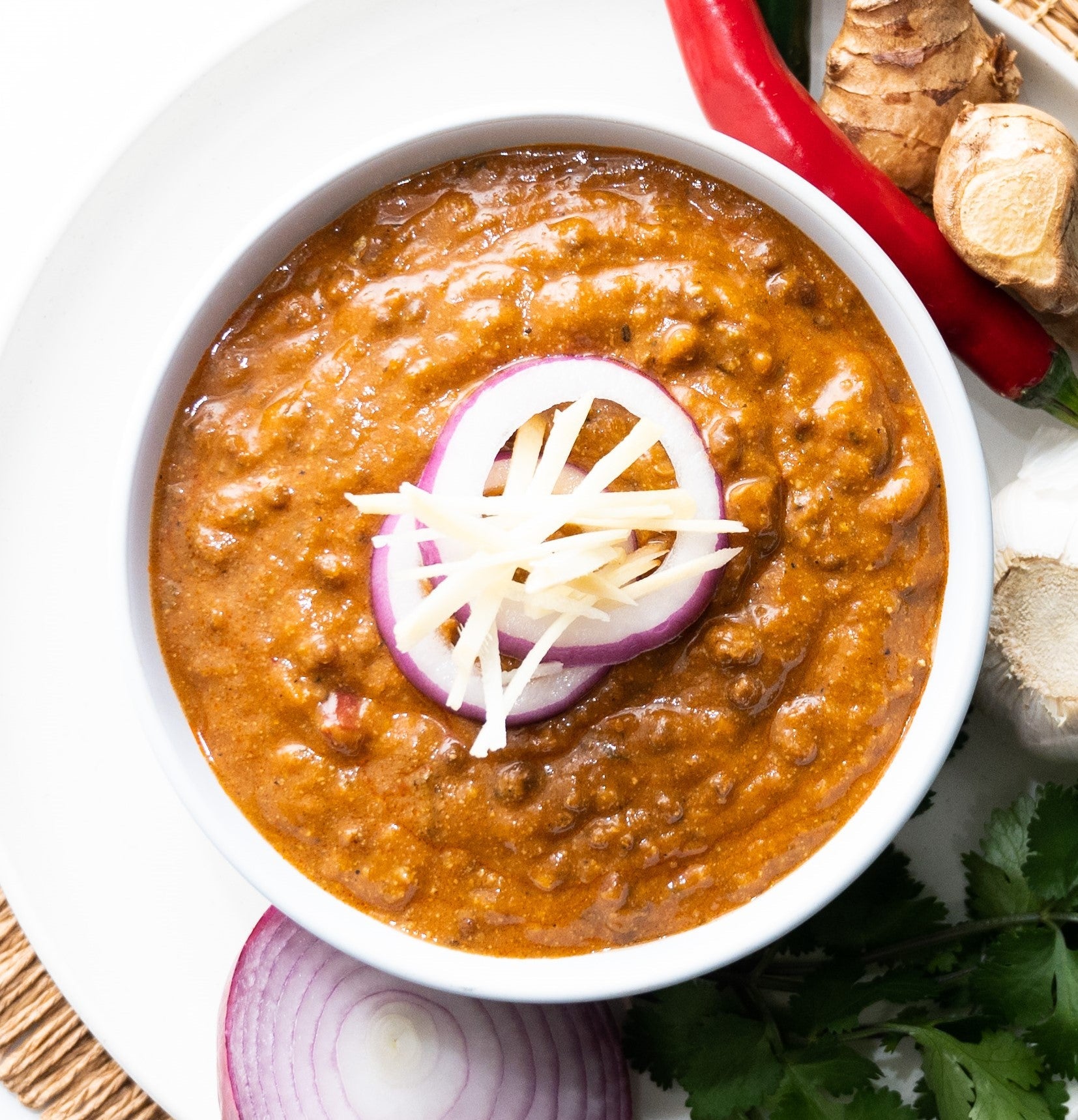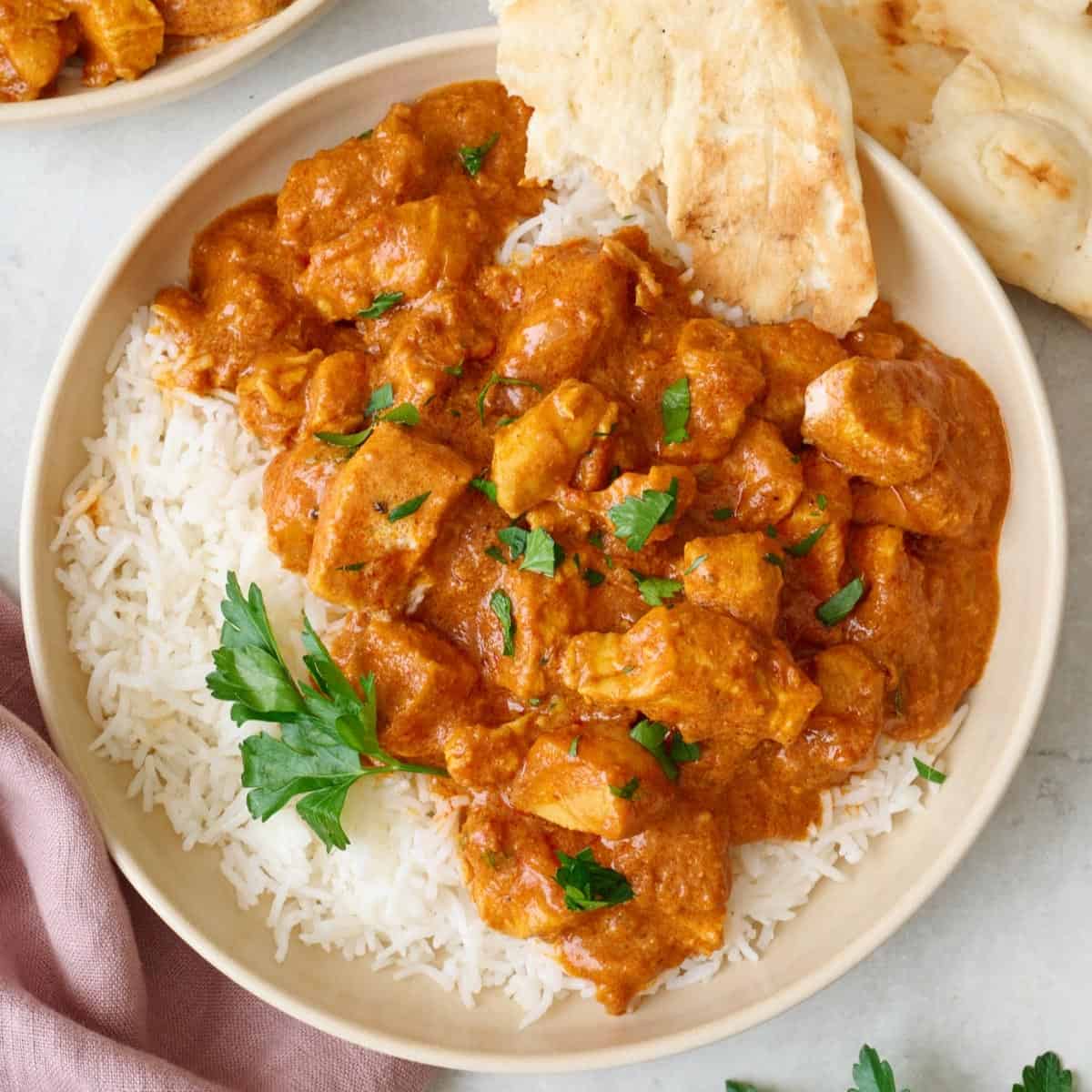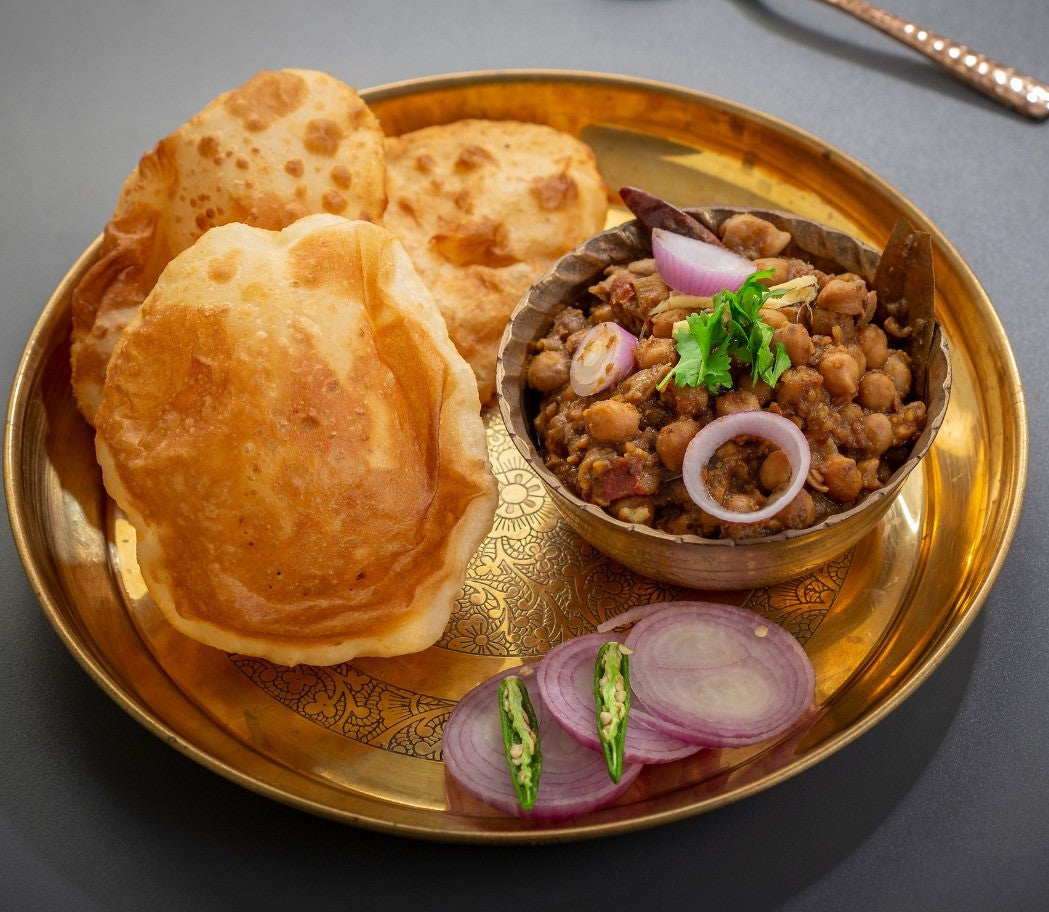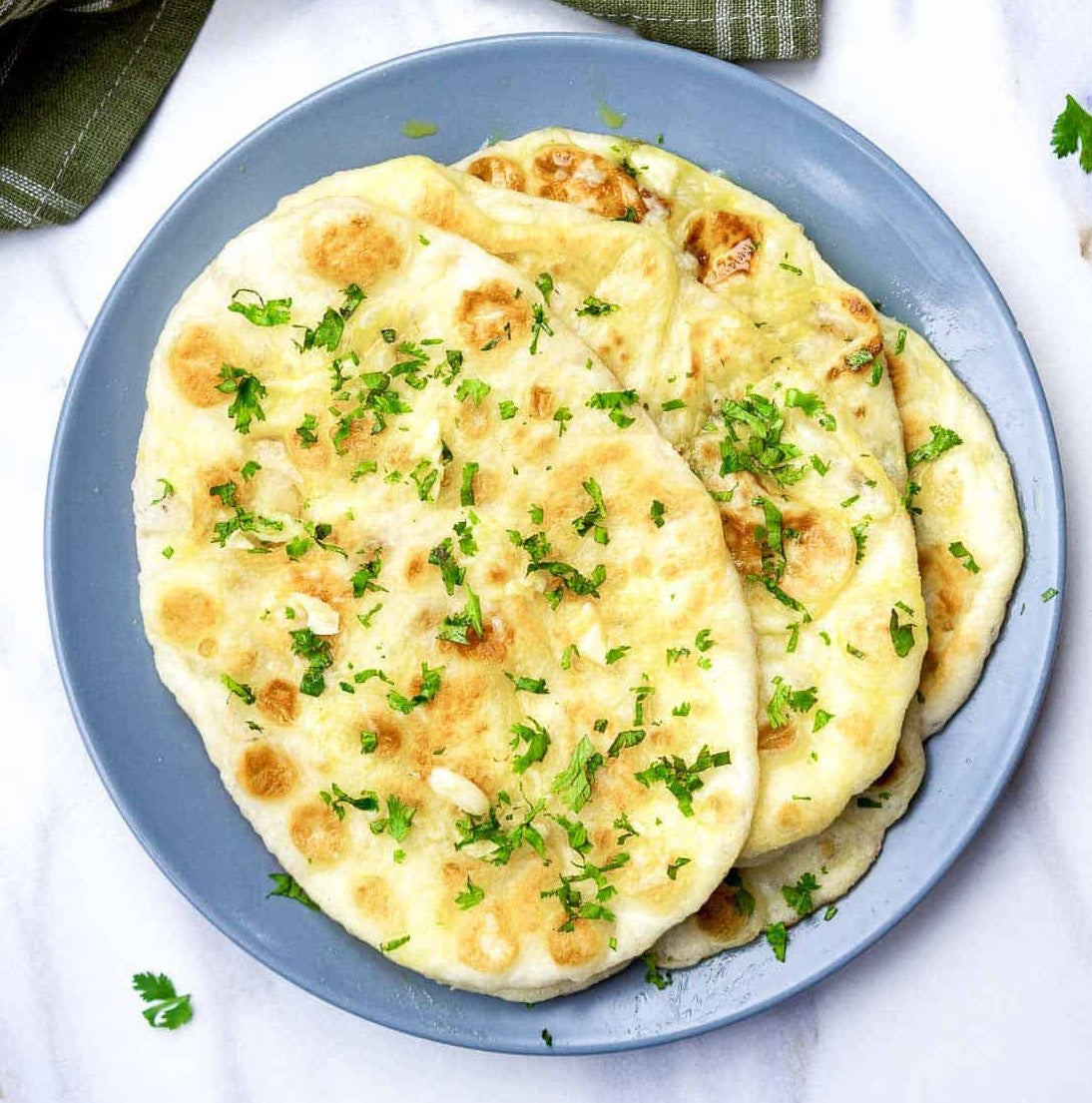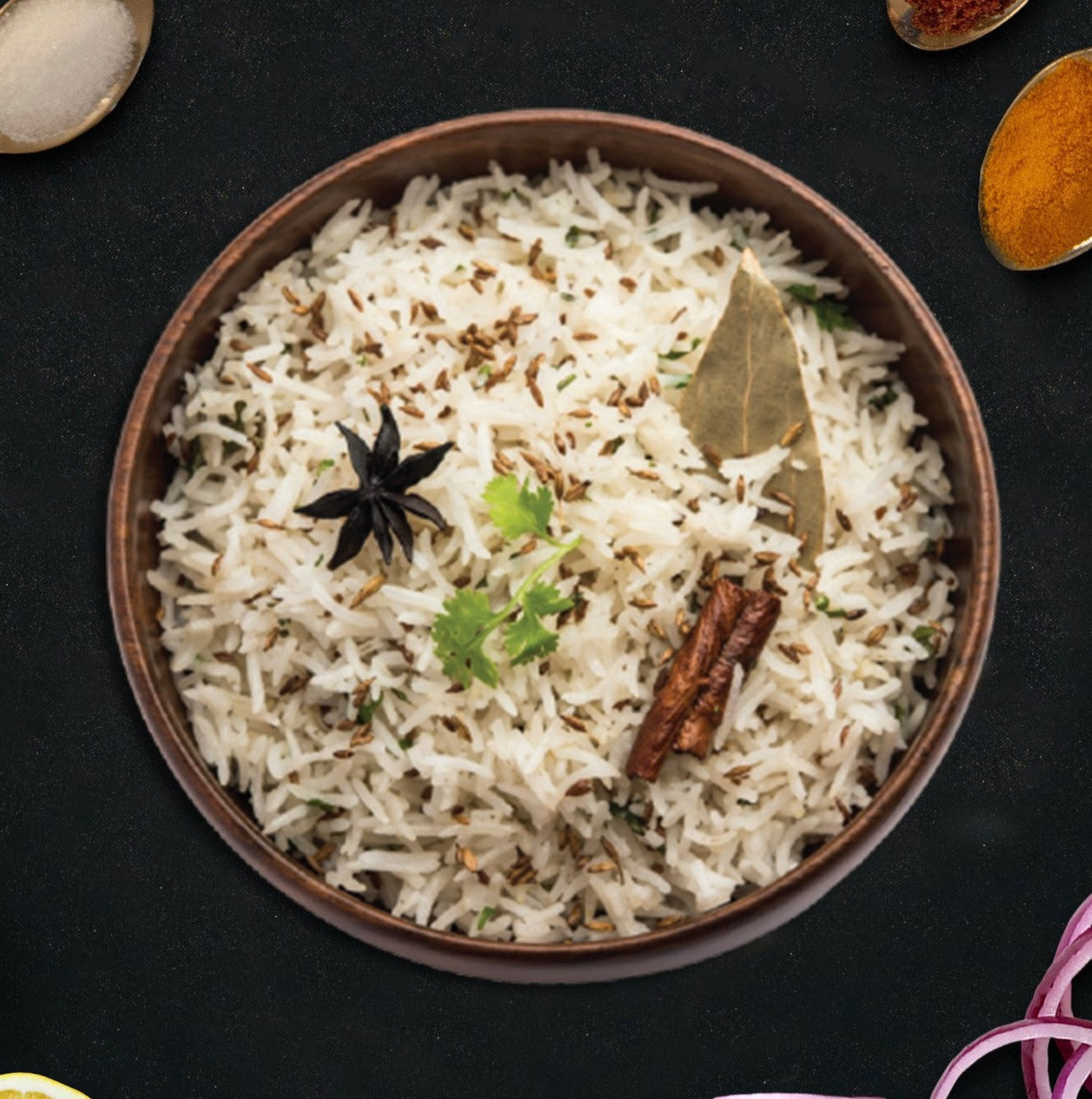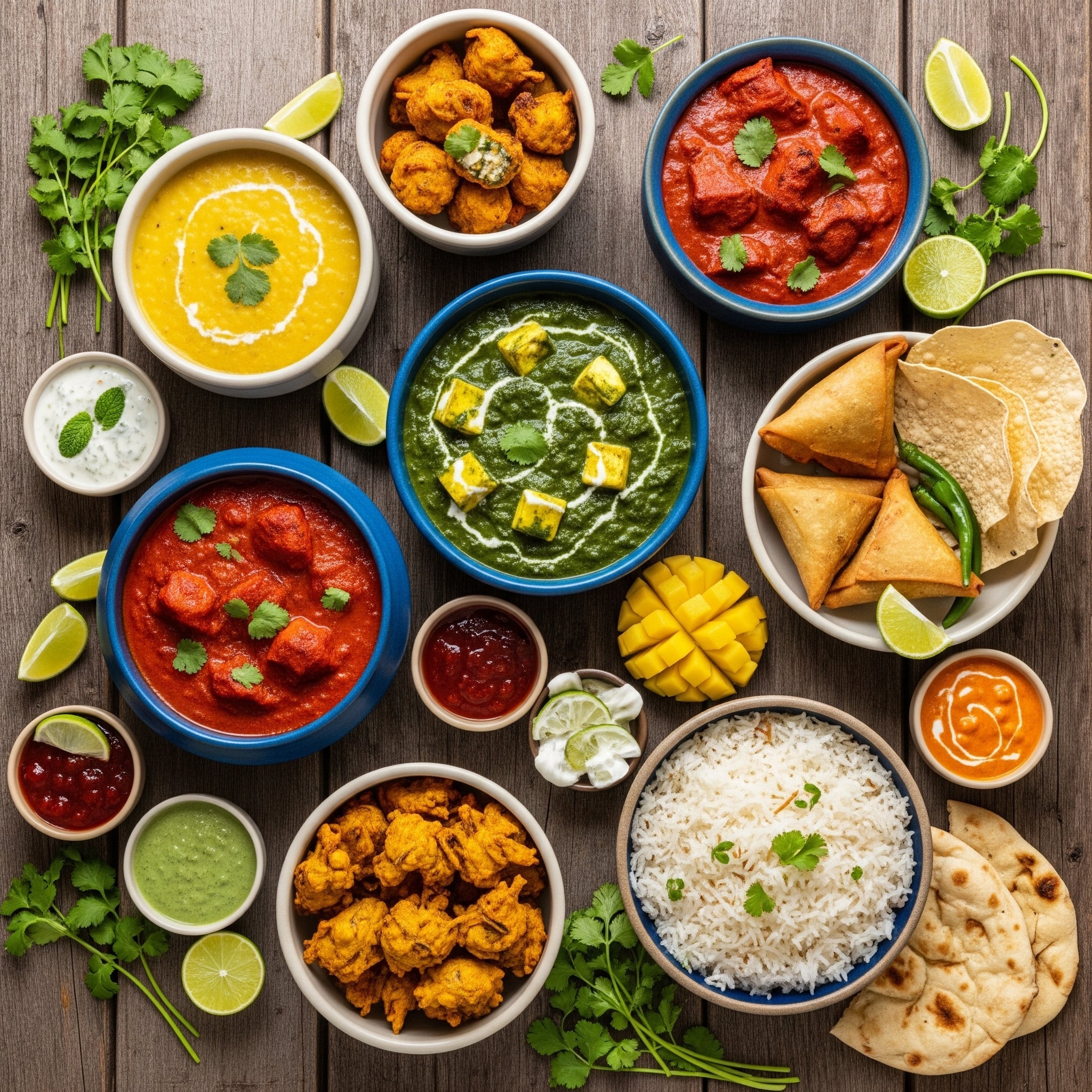
cumin indian cuisine: Essential Flavor Guide
If you've ever tried to recreate an Indian dish at home and felt something was missing, the answer is very likely cumin. Known as jeera in India, this humble spice is the earthy, warm, and slightly peppery soul of countless recipes, from the simplest dal to the most elaborate biryani. For anyone in Australia looking to get that authentic desi khana taste, getting to know cumin is your first and most important step.
The Aromatic Heart of Indian Cooking

That incredible, welcoming smell wafting out of an Indian restaurant? That's almost certainly cumin working its magic. It’s far more than just another spice in the rack; it forms the very flavour backbone of Indian cooking.
Think of it like the bassline in your favourite song. It’s not always the loudest or most obvious part, but take it away, and the whole thing just falls flat. Cumin provides that deep, savoury foundation, a canvas on which brighter spices like turmeric, coriander, and chilli can truly shine.
Why Cumin is Your Starting Point
For home cooks in Australia just dipping their toes into Indian food, cumin is the perfect place to start. Its flavour is instantly recognisable and absolutely essential for getting that authentic taste you're after. Once you get the hang of using it, a whole world of culinary possibilities opens up.
- The Flavour Base: Cumin is often the very first spice to hit the hot oil in a technique called tadka (or tempering), which creates a fragrant foundation for the entire dish.
- A Spice of Two Forms: You can use the whole seeds for little bursts of texture and flavour, or grind them into a powder to blend seamlessly into curries, marinades, and rubs.
- The Great Unifier: While cooking styles change dramatically from north to south, cumin is one of the few constants you'll find in kitchens from Punjab to Kerala.
Cumin isn't just a spice; it's a culinary anchor. It has this incredible ability to be a star on its own while also making every other ingredient taste better. It’s the common thread of earthy warmth connecting countless regional dishes.
This guide will take you beyond just shaking some cumin powder into a pot. We’ll get into the techniques that unlock its true potential, from knowing exactly when it 'blooms' in hot oil to understanding the subtle differences between its varieties. By the end, you won't just appreciate cumin—you'll be using it with confidence, creating meals that taste like they've been passed down through generations.
A Spice with a Story: The Varieties of Cumin
Every spice has a story, and cumin’s is a fascinating one. It’s a tale of ancient trade routes, medicinal traditions, and, ultimately, culinary conquest. This humble seed travelled all the way from the Mediterranean, finding its true calling in the heart of India. It didn't take long for it to become more than just an ingredient; it was woven into the fabric of daily life, valued in Ayurvedic practices for helping digestion and celebrated in the kitchen for its deep, earthy flavour.
Today, India’s bond with cumin is stronger than ever. In fact, the nation is the world's cumin powerhouse, growing around 70% of the entire global supply. This incredible output, mostly from the states of Gujarat and Rajasthan, is what keeps kitchens from Melbourne to Mumbai stocked with this essential spice. If you're curious about the scale of this operation, Tasting Table has some great insights into India's massive contribution.
But here’s something crucial to understand: thinking all cumin is the same is like saying all wine tastes alike. Indian cooking masterfully uses three distinct types, each with its own personality and purpose. Let's get to know them.
The Everyday Essential: Brown Cumin (Jeera)
When someone says "cumin," this is almost certainly what they mean. Known simply as jeera, this is the absolute workhorse of the Indian spice box (masala dabba). Its flavour is warm, nutty, and earthy, with just a little bit of a pungent kick.
This is the foundational note in countless dishes, providing a savoury depth that all other spices build upon. You'll find it sizzling in hot oil to start a dal, ground into marinades for tandoori chicken, and toasted to perfection in a simple jeera rice. Its incredible versatility makes it the indispensable, go-to cumin for daily cooking.
The Aromatic Specialist: Shahi Jeera (Caraway/Persian Cumin)
Next up is Shahi Jeera. The name itself, "shahi," translates to "royal," which gives you a perfect clue about its character—it's more refined and delicate. The seeds look different, too; they're thinner, darker, and more curved than regular jeera.
Shahi Jeera is the secret weapon in rich, celebratory dishes. Its flavour is less earthy and more sweetly aromatic, with subtle smoky and floral notes that are key to authentic Mughlai cuisine, biryanis, and special occasion curries. It adds a layer of complexity that instantly makes a meal feel a bit more decadent.
You wouldn't toss this into a simple lentil soup, but for a dish designed to impress, Shahi Jeera is non-negotiable. Its nuanced aroma is best preserved by adding it later in the cooking process, allowing it to gently perfume the dish without getting lost.
The Bold and Pungent: Kala Jeera (Black Cumin)
Finally, we have Kala Jeera, or black cumin. This one is the most misunderstood of the trio and is often confused with nigella seeds (kalonji), but they are entirely different. Kala Jeera seeds are tiny, dark, and pack an intensely pungent punch with a sharp, peppery, and almost bitter flavour.
With this spice, a little goes a very long way. It's rarely the star of the show. Instead, it’s added in small amounts to complex masalas, pickles, and certain naan breads to provide a distinctive, sharp kick. Its robust flavour holds its own against other strong ingredients, making it a favourite in specific regional recipes that call for a bold, unforgettable taste.
To make sense of it all, it helps to see them side-by-side.
Understanding Cumin Varieties in Indian Cooking
| Cumin Type | Flavour Profile | Appearance | Common Use in Indian Dishes |
|---|---|---|---|
| Brown Cumin (Jeera) | Warm, earthy, nutty, slightly pungent | Small, oblong, brownish-yellow seeds | Everyday dals, vegetable curries, jeera rice, spice blends |
| Shahi Jeera (Caraway) | Sweet, smoky, mildly anise-like | Thinner, darker, curved seeds | Royal biryanis, rich Mughlai curries, special pulaos |
| Kala Jeera (Black Cumin) | Intensely pungent, peppery, slightly bitter | Tiny, slender, very dark brown seeds | Specific breads (naan), pickles, some rich meat dishes |
Choosing the right cumin is one of the first real steps toward mastering authentic Indian flavours. Each one has a specific job to do, and knowing when to reach for which variety will take your cooking from good to truly exceptional.
Mastering the Art of Cooking with Cumin
Knowing about the different types of cumin is one thing, but actually using them to create authentic, mouth-watering Indian dishes is where the real magic happens. It’s all about technique. Once you get the hang of a few key methods, you’ll transform your cumin from a simple spice into the heart and soul of your cooking, unlocking layers of flavour you never knew existed.
The journey of cumin from a simple seed to a complex flavour agent is a story of transformation. This process visualises its path from ancient trade routes to the heart of the Indian kitchen.

This simple flow highlights how a globally traded spice became deeply embedded in Indian culinary identity, eventually finding its way into modern kitchens where its potential is fully realised.
The Cornerstone Technique: Tadka
If you learn only one technique for cooking with cumin, make it tadka (also called tempering or chhaunk). This isn't just another step in a recipe; it's the moment the dish’s flavour base is born. Think of it like searing a steak to lock in the juices—tadka wakes up and pulls out the essential oils from the spices, infusing the entire meal with a deep, aromatic character.
The process is straightforward but needs your full attention. Heat a small amount of oil or ghee until it's shimmering, then toss in your whole cumin seeds. Within seconds, they'll start to sizzle and dance, releasing that signature nutty fragrance. That's the "bloom," and it’s your cue that the flavour has been released into the oil. This fragrant oil then becomes the foundation of your dish, poured over dal, curries, or vegetables to finish them off.
Whole Seeds Versus Ground Powder
Choosing between whole seeds and ground powder is a strategic decision that completely changes the final dish. One isn't better than the other; they simply have different jobs to do.
- Whole Cumin Seeds: Use these when you want texture and little pops of flavour. When you add them to a tadka or toast them for a rice dish like Jeera Rice, they give a lovely, subtle crunch and release their flavour in small, surprising bursts.
- Ground Cumin Powder: This is for deep, uniform flavour. When you need that earthy warmth of cumin to blend seamlessly into a gravy, marinade, or spice rub, the powder is your go-to. It dissolves into the mixture, making sure every single spoonful has that consistent cumin note.
The secret to exceptional Indian cooking often lies in layering. You can start a recipe by using whole cumin seeds to build a fragrant base, then add ground cumin later with other powdered spices. This creates a dish with remarkable depth and complexity.
Unlocking Deeper Flavour: Toasting and Grinding
For the most intense and aromatic cumin flavour, nothing beats dry-toasting whole seeds before grinding them yourself. It's a simple step that takes the spice from good to absolutely incredible.
Toasting awakens the volatile oils inside the seeds, making them far more fragrant and mellowing out any harshness. All you do is toss the seeds in a dry pan over medium heat for a minute or two, swirling them constantly. You’ll know they’re ready when they darken slightly and release a powerful, nutty aroma.
Once toasted, let them cool completely before grinding them in a spice grinder or with a good old-fashioned mortar and pestle. The difference in taste compared to pre-packaged ground cumin is astonishing. It’s the single easiest way to make your homemade Indian curries taste like they came from a restaurant.
Timing is Everything: When to Add Cumin
When you add cumin is just as important as what form you use. You can’t just toss it in whenever you feel like it.
- At the Beginning: Frying whole cumin seeds in hot oil right at the start (the tadka) builds the foundational aromatic base for the whole dish.
- In the Middle: Adding ground cumin along with other powdered spices like coriander and turmeric allows it to cook into the sauce, melding with the other ingredients to create a rich, cohesive flavour.
- At the End: A final sprinkle of freshly roasted and ground cumin just before serving acts as a finisher, adding a fresh burst of aroma that hits you the moment the plate is served.
By mastering these techniques—tempering, choosing between whole and ground, and timing your additions—you move beyond just following a recipe. You start to cook with intuition, using cumin to build flavour with purpose. And that, right there, is the true art of Indian cuisine.
A Flavour Tour of Regional Cumin Specialties
To really get a feel for cumin in Indian cuisine, you need to take a trip across the country—even if it's just with your taste buds. India’s food scene is unbelievably diverse; the flavours, ingredients, and cooking methods can change dramatically every few hundred kilometres. And yet, cumin is the one spice that ties it all together, adapting its personality to match the unique character of each region. It’s a true culinary chameleon, capable of being bold and assertive in one dish while offering a subtle warmth in another.
This flavour tour shows just how versatile one little seed can be. From the rich, hearty meals of the North to the intricate spice blends of the South, cumin is always there, playing a pivotal role in creating those authentic, regional tastes. It's like the secret handshake connecting a vast and varied culinary tradition.
The Hearty North
Up in North India, cumin’s flavour is confident, earthy, and impossible to miss. It forms the very backbone of many world-famous dishes. It's not just an ingredient; it's the foundational flavour that everything else is built on.
Take an iconic dish like Dal Tadka, where whole cumin seeds are sizzled in hot ghee and poured over cooked lentils right at the end. That final tadka isn't just for dramatic effect—it's an explosion of nutty aroma and flavour that completely defines the dish. In the same way, ground cumin brings a deep, savoury warmth to rich chickpea curries like Chana Masala, perfectly balancing the tang of tomatoes and the sharpness of onions.
The Vibrant West
Head west to states like Gujarat and Maharashtra, and you'll find cumin playing a much livelier, more aromatic role. It's a key player in the region’s famous street food and vegetarian specialities. Here, it’s often dry-roasted with coriander seeds to create a fragrant powder called dhana jeera, a cornerstone of Gujarati cooking.
This blend gives dishes like Khandvi their signature flavour and is often sprinkled over snacks like Dhokla. Over in Maharashtra, cumin is essential to the complex spice mix known as goda masala, lending its earthy notes to all sorts of lentil and vegetable dishes. Its presence is both grounding and uplifting—a perfect match for the region's vibrant food culture.
Cumin’s regional journey is a perfect example of culinary adaptation. The same spice that provides deep, smoky warmth to a Punjabi curry can offer a light, toasty aroma to a Gujarati snack. It all comes down to the local palate and cooking techniques.
The Complex South
In the South, cumin tends to be more of a team player. It rarely takes the spotlight alone, instead blending seamlessly into intricate spice powders like Sambar Podi and Rasam Podi. Its job here is to provide an earthy bass note that supports the brighter, sharper flavours of ingredients like tamarind, black pepper, and mustard seeds.
This warmth helps to round out the tangy, spicy profiles of dishes like Sambar (a lentil and vegetable stew) and Rasam (a peppery, tamarind-based soup). While its flavour might be less obvious than in a Northern curry, you'd notice its absence immediately. The entire balance of these complex spice blends relies on cumin’s grounding presence.
The Subtle East
Finally, over in Eastern India, particularly in Bengali cuisine, cumin is used with a much lighter touch. It’s a key component of the famous panch phoron, a five-spice blend that also includes fenugreek, nigella, fennel, and mustard seeds.
When this mix is tempered in oil, it creates a wonderfully complex aroma that forms the base for countless vegetable dishes and fish curries. Even a simple side of rice can be transformed with this spice. If you’re looking for an easy yet flavourful meal, a simple rice dish with toasted cumin seeds is a fantastic option. You can see just how this is done with ready-to-eat options like Jewel of Asia's Jeera Rice, which perfectly captures this aromatic simplicity.
How to Buy and Store Cumin for Peak Flavour
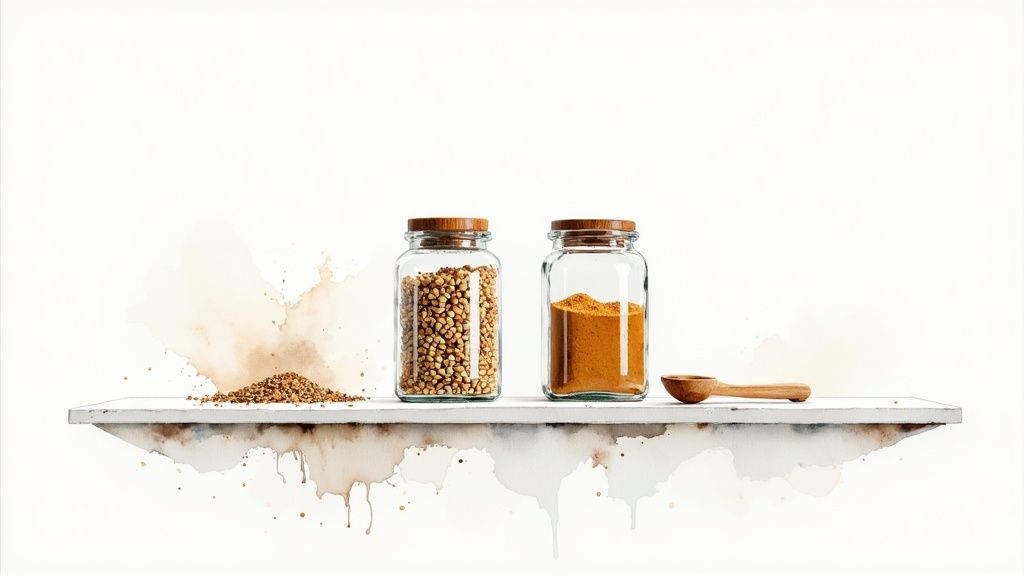
To cook truly authentic Indian food, you need spices that are full of life. Just like using fresh herbs over dried ones, the freshness of your cumin makes a massive difference. Learning how to buy and store it properly means every pinch will pack that deep, earthy punch you're looking for, making every dish sing.
So, whole seeds or ground powder? It’s an easy choice. For the absolute best, most vibrant flavour, always choose whole cumin seeds. Think of them like coffee beans; the moment you grind them, their fragrant oils start to disappear into the air. Pre-ground cumin is certainly convenient, but it will never have the same aromatic power as seeds you’ve just freshly ground yourself.
What to Look for When Buying Cumin
When you’re browsing the spice aisle, let your senses guide you. There are a few dead giveaways for quality and freshness, whether you’re buying seeds or powder.
- Whole Seeds: They should look plump and have a consistent brownish-yellow colour. Steer clear of packets with seeds that look dusty, faded, or are full of broken bits and stems. A good batch will have a strong, nutty aroma that you can almost smell through the packaging.
- Ground Cumin: Look for a vibrant, rich brown colour. If the powder looks pale, greyish, or is clumping together, it's probably old. The smell should still be potent and earthy. A weak or dusty scent is a sure sign it’s past its prime.
Australia’s love for genuine Indian food has created a huge demand for high-quality spices. Thankfully, most of the cumin here is imported directly from India, which is known for producing the world’s most flavourful varieties. Between late 2023 and 2024, Australia imported over 2,400 shipments of cumin—nearly all from India—which shows just how vital this spice is in our kitchens. You can explore more data on Australia's spice imports to see just how popular cumin in Indian cuisine has become down under.
Storing Cumin for Long-Lasting Freshness
Once you've got your cumin home, storing it correctly is the secret to keeping its flavour and aroma locked in. The biggest enemies of your spices are light, heat, and air.
The goal is simple: keep your spices in a cool, dark, and dry place. A pantry or a cupboard that’s well away from the stove or any direct sunlight is ideal. A spice rack right above the cooktop might look convenient, but the constant heat will kill the flavour in no time.
Just follow these simple rules:
- Use an Airtight Container: Get your cumin out of its original flimsy packet and into a small, airtight glass or metal tin. This keeps out air and moisture, preserving its potency.
- Keep it Whole: Store the cumin seeds whole for as long as you can. They’ll stay fresh and flavourful for up to a year, while ground cumin starts to lose its magic after just a few months.
- Grind as You Go: A small spice grinder or a classic mortar and pestle is your best friend here. Grind only what you need, right when you need it. That incredible burst of fresh aroma is your immediate reward.
The Health Benefits of Cumin
Beyond its incredible flavour, cumin is a little powerhouse of wellness, with roots stretching deep into centuries of Ayurvedic tradition. For generations, it hasn't just been a way to season food, but a go-to natural remedy. Now, modern science is starting to catch up with what Indian grandmothers have known all along—this humble spice is a simple, delicious step toward better health.
One of cumin’s most famous jobs is helping with digestion. It gets to work by encouraging your pancreas to produce more of the enzymes needed to break down food and absorb nutrients properly. This is exactly why a warm glass of jeera water is such a common and comforting remedy for an upset stomach across India.
An Unsung Nutritional Hero
Cumin is also a surprisingly good source of iron, a mineral that’s crucial for keeping your energy levels up and your mind sharp. In fact, a single teaspoon of ground cumin can deliver a significant chunk of your daily iron requirement, making it an effortless way to boost your intake.
On top of that, cumin is packed with powerful plant compounds that act as antioxidants. These little warriors help protect your body from the daily grind by neutralising damaging free radicals. Adding cumin to your cooking is a genuinely tasty way to bolster your body's natural defences.
Cumin is so much more than a simple seasoning in cumin indian cuisine; it's what you'd call a functional food. Its constant presence in everyday meals, from lentil dals to veggie stir-fries, offers consistent wellness benefits that have been woven into the culture for thousands of years.
Supporting Your Overall Wellbeing
And the benefits don't stop there. Early research suggests that cumin may also help support healthy blood sugar and cholesterol levels, making it a valuable ally in a balanced diet. Its natural anti-inflammatory properties only add to its impressive resume.
Making cumin a regular feature in your meals is easier than you think, especially with its central role in the Indian food we love here in Australia. Studies looking at how spices are used in Indian households—which heavily influence our local culinary scene—show that many staple dishes like chutneys and dhal contain over one gram of cumin per serving.
This regular use cements cumin's place not just as a flavour, but as a culturally vital part of everyday cooking. You can dive deeper into these consumption habits in a fascinating study on Indian spice usage. By simply sprinkling this aromatic spice into your meals, you're tapping into a tradition that is as nourishing as it is delicious.
Common Questions About Cumin in Indian Cooking
Diving into the world of Indian spices often raises a few questions, especially with an ingredient as foundational as cumin. Nailing the basics here is the secret to taking a dish from good to truly memorable. Let's tackle some of the most common queries so you can get into the kitchen with total confidence.
Getting these details right will help you master the subtleties of using cumin in Indian cuisine, making sure every meal you create is bursting with authentic flavour.
What Is the Real Difference Between Seeds and Powder?
Think of cumin seeds as the whole, dried fruit of the plant. When you pop them into hot oil for a tadka, they toast up and release this incredible, nutty aroma, adding a lovely little textural crunch to your dish. They're like tiny flavour bombs waiting to go off.
Ground cumin, on the other hand, is just those seeds pulverised into a powder. It delivers an instant, earthy hit that melts seamlessly into sauces, marinades, and spice rubs. The trade-off? Because all its fragrant oils are exposed to the air, it loses its punch much faster than whole seeds.
For the best possible flavour, always try to start with whole cumin seeds. Grinding them yourself just before cooking unleashes an aromatic power that pre-ground powders just can't compete with. It’s the single biggest upgrade you can make to your spice game.
Can I Substitute Another Spice for Cumin in Indian Food?
Cumin has a flavour profile that’s truly its own, but if you're in a real pinch, you have a couple of options—just know they won't be a perfect match. Caraway seeds are a close cousin and can work, but be warned: they have a sharper, more anise-like flavour that will definitely alter the dish's character.
Ground coriander is another possibility. It brings its own kind of earthy, citrusy notes to the table, but it completely lacks that signature smoky depth that makes cumin so special. For a genuinely authentic Indian dish, there really is no perfect substitute for the distinctive warmth of cumin.
Is Black Cumin the Same as Nigella Seeds?
Nope, and this is probably one of the most common mix-ups for home cooks. They are entirely different spices from different plants, and you can't swap one for the other.
- Black Cumin (Kala Jeera): This is a relative of regular cumin. The seeds are smaller, darker, and carry a sweeter, more peppery flavour. It’s often used in rich, celebratory dishes like biryanis.
- Nigella Seeds (Kalonji): These are the jet-black, tear-drop shaped seeds with a pungent, slightly bitter, and almost onion-like taste. You’ll often see them sprinkled on top of naan bread.
For more detailed answers to all your cooking questions, you can always check out the comprehensive guide on our Frequently Asked Questions page.
Ready to enjoy authentic Indian flavours without the fuss? Let Jewel of Asia handle the cooking. Explore our menu of over 50 chef-crafted, ready-to-eat meals delivered right to your door. Visit us at https://www.jewelofasia.com.au and bring home the taste of real desi khana today.
Share

